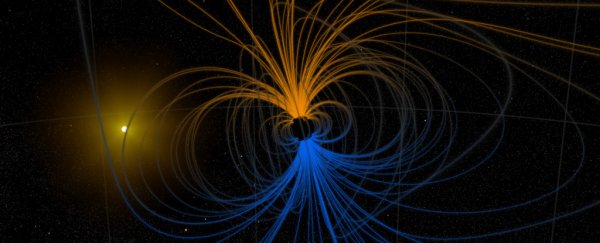Half a billion years ago, when trilobites ruled and dry land was a barren wasteland, Earth was having a terrible time making a decision. North and south had switched places nearly 80 times in just a few million years, making it one of the most geomagnetically turbulent moments in history.
Geologists from the Russian Academy of Science and the Institut de Physique du Globe de Paris in France measured the orientations of tiny magnetised particles in rock samples from northeastern Siberia.
The source was a set of crumbling cliffs overlooking the Khorbusuonka River – a legacy of a time 500 million years ago when the region's landscape was covered in water.
As tiny particles of magnetite and hematite drifted in the waters, they aligned with the planet's magnetic field. Once locked in place among the sediment, they became a permanent record of the compass points at that time.
Of particular interest to the team were the layers of grit that corresponded with a stage of the Cambrian called the Drumian. Based on the results of their previous study, the researchers estimated around half a dozen polarity reversals took place every million years or so during this particular stage of history.
But the data wasn't as comprehensive as they'd liked, so in 2016 they returned for another look. From 437 new samples, the geologists identified a total of 78 shifts in polarity over a 3 million year period.
This suggests an astonishing maximum frequency of 26 reversals per million years. Even if they're being conservative with their sums and only counting consecutive samples showing polarity swaps, the rate is still around 15 reversals.
For some reason, this intense period of magnetic musical chairs dropped off in the later part of the Cambrian to just 1.5 flips per million years.
Such a stark difference in frequency suggests that whatever is causing these reversals deep inside our planet's churning guts, it's not a subtle process. In fact, two very different modes in Earth's field-generating dynamo could be at work.
We've understood for some time that the flip-flopping of Earth's magnetic field has varied in frequency. Over the past 20 million years, for example, the poles have switched places roughly every few hundred thousand years or so. The last big swap was about 780,000 years ago.
There have been blocks of tens of millions of years where not a lot of change can be detected. Referred to as superchrons, they are probably driven by a drop in the flow of heat between the core and mantle.
At the other extreme, there are earlier signs of intense flipping deep in the geological record. During the Ediacaran Period around 550 million years ago, the magnetic field went a little nuts, reversing 24 times every million years.
What's more, some researchers think these rapid swaps could have even been behind an ecological catastrophe called the Kotlinian Crisis, a major extinction event that marks the end of that geological period.
Identifying clues surrounding the frequency and periodicity of these events over vast time scales could help us not only better explain why the magnetic field can change so dramatically, it could help us to better predict future flips.
The question of whether we're about to see a full reversal in our planet's polarity has been a hot topic in geology circles. Something odd is definitely going on, but whether it's an imminent reversal or just a drifting pole, it's hard to say.
If it does change, there are also questions on whether it's a sudden switch over centuries or a drawn-out process over millennia, and whether it will put technology or even life at risk of uncomfortably high doses of radiation.
With so many unanswered questions, and such potential risks, it's vital we step back to see what history has to say.
This research was published in Earth and Planetary Science Letters.
